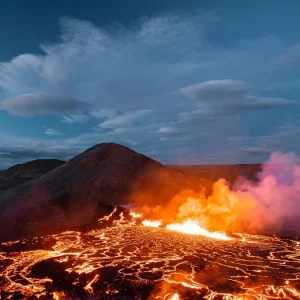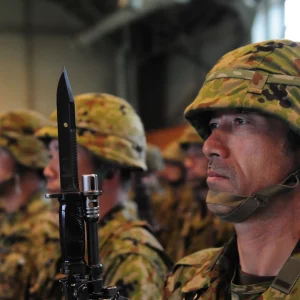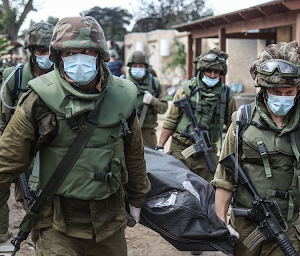
100 tons of plutonium, 1,000 tons of highly enriched uranium, and 30,000 nuclear warheads make up the known Russian nuclear arsenal today. However, following the disintegration of the Soviet Union in 1991, large parts of the USSR’s vast arsenal of nuclear-grade weaponry were left scattered and unmonitored, meaning the actual arsenal size may be much larger. In one instance, two million nerve gas shells lay abandoned in rotting barnyards with unlocked doors and no security in sight. With no system for monitoring or decommissioning nuclear materials, countries such as Moldova and Georgia have an unknown amount of nuclear material potent enough to make dirty bombs and potentially high-grade nuclear weapons.
Today, many of the materials are in the hands of vast criminal networks, which purposefully hid away nuclear materials when the USSR collapsed and now look to profit from sales to extremist groups such as the Islamic State (ISIS). Failed attempts by the FBI and Georgian and Moldovan authorities to curtail this network in recent years due to misguided approaches of capturing suspects in sting operations prompt the need to evaluate if and how other actors, such as the International Atomic Energy Agency, the International Campaign to Abolish Nuclear Weapons (ICAN), and the UN’s Missile Technology Control Regime, can work together to solve this problem.
With profound political instability rocking not only the U.S.-Russia relationship but also the Georgian-Russian relationship, narratives from government officials on both sides differ significantly. Matthew Bunn, a former White House science adviser, best describes the situation: “Of what iceberg are we seeing the tip?” Depending on whom you ask, nuclear materials could have originated anywhere surrounding Russia between Turkey and Abkhazia, an unrecognized country south of Russia. Economic instability in these regions has led to former military officials, businessmen, and chemical engineers to engage in these underground networks and sell to terrorist groups such as al-Qaeda and ISIS. Past attempts to remedy the problem of an unregulated nuclear arsenal have either ceased or have proved futile. Two decades ago, the U.S. began decommissioning former Soviet warheads, creating a strong win-win situation. The Russians made $17 billion selling 500 tons of converted bomb-grade uranium, which fuelled 10 percent of total U.S. energy consumption. Nonetheless, such a process was halted indefinitely in late 2013 because of increasingly strained U.S.-Russian political relations.
Despite the Russian government stating otherwise, the U.S. State Department remains aware that nuclear materials exist in former Soviet territories. Today, in countries such as Georgia, nuclear bomb-grade uranium and plutonium and potent dirty-bomb ingredients such as cesium and iridium are central to the black market economy. 225 miles of porous borders along South Ossetia and Abkhazia — breakaway Georgian territories to Russia’s south — and profound economic instability goad individuals into the lucrative and mostly undetectable smuggling business along the Caucasus trade route. As an added incentive, despite U.S.-funded radiation sensors stationed along border crossings, anonymous smugglers can still neatly escape detection by hiding materials in lead-lined containers.
While more recent security forces have had a string of successful catches, two key issues undermine their overall mission. First, since the inception of the sting operation program in 2010, investigators have often relied on the same flawed procedures by acting too soon in capturing lower level suspects. This is at the expense of letting those higher up in the chain of command escape, creating a situation where it is completely unknown if those who escape potentially have an even larger supply of the nuclear material with them. Furthermore, when kingpins are caught and jailed, they either evade long sentences or are often released after only a couple of years to return to the same business.
After the U.S. helped fund a specialized nuclear police unit in 2005, 15 investigations in Georgia have led to dozens of arrests. However, many of these investigations only tried to discover setups that sold nuclear bomb-grade material rather than dirty-bomb ingredients such as cesium and iridium. The scope of the investigations needs to be all encompassing. Otherwise, if the detection of trade in lower-grade materials is not prioritized, and cesium and iridium land in the hands of terrorist groups like al-Qaeda, they can accumulate the material and create dirty bombs strong enough to obliterate a city center. In a worst-case scenario, according to the U.S. National Defense University, the economic impacts of such a city attack could outweigh that of 9/11.
The second limitation in current approaches is possible false advertising on the black market. This makes it more difficult for law enforcement to find the genuinely hazardous supplies that can be enriched into nuclear weapons. For instance, this February, dirty bomb material cesium-137 was advertised on the black market as capable of “wiping out several blocks”, but proved to be unusable in making a dirty bomb. In contrast, a case in 2011, and in 2012, materials such as yellowcake uranium turned out to be strong enough to be used in nuclear bombs. The sellers were looking specifically to sell to ISIS. Until the approach to these two issues of capturing suspects and rooting out false advertising is modified, the Caucasus trade route will continue to remain a lucrative option for extremist groups.
New comprehensive, technologically advanced investigative techniques backed by the International Atomic Energy Agency (IAEA) may help dismantle this network. For instance, new, sensitive nanotechnology sensors are lower cost than older sensors and, once present along seaboards and railroads, can specifically determine what type of nuclear material is being smuggled. International organizations that rely on people-centric movements, such as the International Campaign to Abolish Nuclear Weapons (ICANW), which mobilizes citizens to persuade their governments to create treaties banning nuclear weapons.
Last but not least, the Russian Federation has been a member of the Missile Technology Control Regime since 1995. The Regime seeks to prevent proliferation of missile technology and unmanned aerial vehicle technology from delivering weapons of mass destruction. This has worked even better than founders had anticipated, as it has grown from 7 nations to 34, with even non-formal adherents of the MTCR implementing stringent export control systems. Such an international governmental coalition could be modeled off the MTCR, in which Georgia and Moldovan membership will help create the common mission of surveillance and cleanup of nuclear materials.
The issues in detangling the underground web in nuclear materials are manifold. However, if former Soviet Union territories modify their current approach of capturing suspects too early on in the investigation process, begin to rely more on existing or newly created international organizations, and translate more stringent nanotechnology surveillance procedures into governmental policy, this may prove to act as a key starting point in dismantling the nuclear materials web that entangles the Caucasus today.





Be First to Comment